Absorption Based Stylized Water
An advanced water shader that samples the screen texture and absorbs defined color values depending on depth. Comes with simple player interactions and refraction. Reflections are possible through Godot’s own post-processing methods, of which I highly recommend reflection probes.
Set up
- Create a new mesh instance with a plane.
- Add a ShaderMaterial with this shader.
- Go to Project Settings > Globals > Shader Globals and add wind_intensity(float), wind_direction(vec3) and player_position(vec3).
- Add suitable noise textures in the shader parameters.
- Add to your player movement script a way to adjust the player_position unifrom through the RenderingServer with the global position.
Fresnel, Displacement, Player Interaction and Caustic (not in the screenshots) effects can be toggled by commenting out the respective #define effects to customize the look in a performance friendly way.
Parameters explanation
- Absorption color – Color that is absorbed from the screen texture
- Fresnel radius – angle at which the Fresnel color is blendet in
- Fresnel color – Color used at high angles
- Roughness – Very low for reflections
- Specular – PBR Specular
- Depth Distance – Considered to be the maximum depth
- Beers Law – How quickly the color absorption ramps up
- Displacement Strength – Wave bump height
- Displacement Scroll Speed – Speed at which the displacement texture is moved across the world
- Displacement Scroll Offset – directional offset by which a copy of the displacement texture is shifted
- Displacement Scale Offset – Scaling factor for the copied texture
- Displacement Scale – base scale of the displacement texture
- Displacement texture – Simplex, Perlin or Cellular
- Edge Thickness – Scale of the edge where neighboring meshes overlap
- Edge speed – speed at which the edge noise texture is scrolled
- Edge noise scale – Size of the edge noise texture
- Edge noise – Cellular noise
- Edge Ramp – Very steep gradient1D texture (0.0 > white, 0.08 > black)
- Influence Size – Size of the waves caused by the player
- Player Wave Frequency – Amount of waves caused by the player
- Player Wave Speed – Speed of the wave animation
- Caustics Size – Scale of the caustic noise
- Caustic Range – Range at which caustics are no longer visible
- Caustic Strength – Strength of the caustic effect
- Refraction Strength – Amount of which the Normal Map offset the screen sample
- Normal Map Strength – Amount of which the Normal Map effects the lighting pass
- Scroll Speed – Speed at which the normal texture is moved across the world
- Scroll Offset – directional offset by which a copy of the normal texture is moved
- Scale Offset – Scaling factor for the copied texture
- Normal Map Scale – base scale of the normal texture
- Normal Map – Cellular
Shader code
shader_type spatial;
render_mode shadows_disabled;
#define CAUSTICS
#define FRESNEL
#define PLAYER_WAVES
#define DISPLACEMENT
// Shader by Malido. Although this is CC0 licensed credit is much appreciated.
// Also if you include this shader in any of your projects i would like to see them (just contact me on GitHub).
group_uniforms color;
uniform vec3 absorption_color : source_color = vec3(1.0, 0.35, 0.0);
#ifdef FRESNEL
uniform float fresnel_radius : hint_range(0.0, 6.0, 0.01) = 2.0;
uniform vec3 fresnel_color : source_color = vec3(0.0, 0.57, 0.72);
#endif
uniform float roughness : hint_range(0.0, 1.0, 0.01) = 0.15;
uniform float specular : hint_range(0.0, 1.0, 0.01) = 0.25;
// Depth adjustment
uniform float depth_distance : hint_range(0.0, 50.0, 0.1) = 25.0;
uniform float beers_law : hint_range(0.0, 20.0, 0.1) = 4.5;
#ifdef DISPLACEMENT
group_uniforms displacement;
uniform float displacement_strength : hint_range(0.0, 5.0, 0.1) = 0.3;
uniform float displacement_scroll_speed : hint_range(0.0, 1.0, 0.001) = 0.1;
uniform vec2 displacement_scroll_offset = vec2 (-0.2, 0.3);
uniform float displacement_scale_offset = 0.5;
uniform vec2 displacement_scale = vec2(0.04);
uniform sampler2D displacement_texture : hint_default_black, repeat_enable;
#endif
group_uniforms edge;
uniform float edge_thickness : hint_range(0.0, 1.0, 0.001) = 0.3;
uniform float edge_speed : hint_range(0.0, 1.0, 0.001) = 0.35;
uniform vec2 edge_noise_scale = vec2(0.4);
uniform sampler2D edge_noise : repeat_enable;
uniform sampler2D edge_ramp : repeat_disable;
#ifdef PLAYER_WAVES
group_uniforms player;
uniform float influence_size : hint_range(0.0, 4.0, 0.1) = 1.0;
uniform float player_wave_frequenzy : hint_range(0.0, 20.0, 0.1) = 10.0;
uniform float player_wave_speed : hint_range(0.0, 10.0, 0.1) = 5.0;
#endif
#ifdef CAUSTICS
group_uniforms caustics;
uniform float caustic_size : hint_range(0.0, 6.0, 0.01) = 2.0;
uniform float caustic_range : hint_range(0.0, 256.0, 0.1) = 40.0;
uniform float caustic_strength : hint_range(0.0, 1.0, 0.01) = 0.08;
#endif
group_uniforms normal_map;
uniform float refraction_strength : hint_range(0.0, 4.0, 0.01) = 1.25;
uniform float normal_map_strength : hint_range(0.0, 4.0, 0.01) = 1.0;
uniform float scroll_speed : hint_range(0.0, 1.0, 0.01) = 0.3;
uniform vec2 scroll_offset = vec2(0.1, -0.3);
uniform float scale_offset = 0.5;
uniform vec2 normal_map_scale = vec2(0.1);
uniform sampler2D normal_map : hint_normal, filter_linear_mipmap;
// Hidden Uniforms
global uniform float wind_intensity; // Global shader parameter between 0.0 and 1.0
global uniform vec3 wind_direction;
#ifdef PLAYER_WAVES
global uniform vec3 player_position;
#endif
uniform sampler2D screen_texture: hint_screen_texture, filter_linear_mipmap, repeat_enable;
uniform sampler2D depth_texture: hint_depth_texture, filter_linear_mipmap;
varying vec3 global_position;
#ifdef CAUSTICS
// Permutation polynomial hash credit Stefan Gustavson
vec4 permute(vec4 t) {
return t * (t * 34.0 + 133.0);
}
// Gradient set is a normalized expanded rhombic dodecahedron
vec3 grad(float hash) {
// Random vertex of a cube, +/- 1 each
vec3 cube = mod(floor(hash / vec3(1.0, 2.0, 4.0)), 2.0) * 2.0 - 1.0;
// Random edge of the three edges connected to that vertex
// Also a cuboctahedral vertex
// And corresponds to the face of its dual, the rhombic dodecahedron
vec3 cuboct = cube;
cuboct[int(hash / 16.0)] = 0.0;
// In a funky way, pick one of the four points on the rhombic face
float type = mod(floor(hash / 8.0), 2.0);
vec3 rhomb = (1.0 - type) * cube + type * (cuboct + cross(cube, cuboct));
// Expand it so that the new edges are the same length
// as the existing ones
vec3 grad = fma(cuboct, vec3(1.22474487139), rhomb);
// To make all gradients the same length, we only need to shorten the
// second type of vector. We also put in the whole noise scale constant.
// The compiler should reduce it into the existing floats. I think.
grad *= fma(-0.042942436724648037, type, 1.0) * 3.5946317686139184;
return grad;
}
// BCC lattice split up into 2 cube lattices
vec4 os2NoiseWithDerivativesPart(vec3 X) {
vec3 b = floor(X);
vec4 i4 = vec4(X - b, 2.5);
// Pick between each pair of oppposite corners in the cube.
vec3 v1 = b + floor(dot(i4, vec4(.25)));
vec3 v2 = b + vec3(1, 0, 0) + vec3(-1, 1, 1) * floor(dot(i4, vec4(-.25, .25, .25, .35)));
vec3 v3 = b + vec3(0, 1, 0) + vec3(1, -1, 1) * floor(dot(i4, vec4(.25, -.25, .25, .35)));
vec3 v4 = b + vec3(0, 0, 1) + vec3(1, 1, -1) * floor(dot(i4, vec4(.25, .25, -.25, .35)));
// Gradient hashes for the four vertices in this half-lattice.
vec4 hashes = permute(mod(vec4(v1.x, v2.x, v3.x, v4.x), 289.0));
hashes = permute(mod(hashes + vec4(v1.y, v2.y, v3.y, v4.y), 289.0));
hashes = mod(permute(mod(hashes + vec4(v1.z, v2.z, v3.z, v4.z), 289.0)), 48.0);
// Gradient extrapolations & kernel function
vec3 d1 = X - v1; vec3 d2 = X - v2; vec3 d3 = X - v3; vec3 d4 = X - v4;
vec4 a = max(0.75 - vec4(dot(d1, d1), dot(d2, d2), dot(d3, d3), dot(d4, d4)), 0.0);
vec4 aa = a * a; vec4 aaaa = aa * aa;
vec3 g1 = grad(hashes.x); vec3 g2 = grad(hashes.y);
vec3 g3 = grad(hashes.z); vec3 g4 = grad(hashes.w);
vec4 extrapolations = vec4(dot(d1, g1), dot(d2, g2), dot(d3, g3), dot(d4, g4));
// Derivatives of the noise
vec4 derivative = -8.0 * mat4(vec4(d1,0.), vec4(d2,0.), vec4(d3,0.), vec4(d4,0.)) * (aa * a * extrapolations)
+ mat4(vec4(g1, 0.), vec4(g2, 0.), vec4(g3, 0.), vec4(g4, 0.)) * aaaa;
// Return it all as a vec4
return vec4(derivative.xyz, dot(aaaa, extrapolations));
}
// Rotates domain, but preserve shape. Hides grid better in cardinal slices.
// Good for texturing 3D objects with lots of flat parts along cardinal planes.
vec4 os2NoiseWithDerivatives_Fallback(vec3 X) {
X = dot(X, vec3(2.0/3.0)) - X;
vec4 result = os2NoiseWithDerivativesPart(X) + os2NoiseWithDerivativesPart(X + 144.5);
return vec4(dot(result.xyz, vec3(2.0/3.0)) - result.xyz, result.w);
}
#endif
#ifdef FRESNEL
float fresnel(vec3 normal, vec3 view) {
return pow((1.0 - clamp(dot(normalize(normal), normalize(view)), 0.0, 1.0 )), fresnel_radius);
}
#endif
vec2 refract_uv(vec2 uv, vec3 normal, float depth){
float strength1 = refraction_strength * depth;
uv += fma(strength1, length(normal), strength1 * -1.2);
return uv;
}
void vertex() {
global_position = (MODEL_MATRIX * vec4(VERTEX, 1.0)).xyz;
#ifdef DISPLACEMENT
float time = TIME * displacement_scroll_speed * fma(wind_intensity, 0.7, 0.3);
float displace1 = texture(displacement_texture, fma(global_position.xz, displacement_scale, time * -wind_direction.xz)).r;
float displace2 = texture(displacement_texture, fma(global_position.xz, displacement_scale * displacement_scale_offset, time * (-wind_direction.xz + displacement_scroll_offset))).r;
float displacement_mixed = mix(displace1, displace2, 0.4);
float offset = fma(displacement_mixed, 2.0, -1.0) * displacement_strength;
VERTEX.y += offset;
global_position.y += offset;
#endif
}
void fragment() {
vec3 opposing_color = vec3(1.0) - absorption_color.rgb;
vec3 normalized_wind_direction = normalize(wind_direction);
float wind_intens_factor = fma(wind_intensity, 0.7, 0.3);
#ifdef FRESNEL
float fresnel_value = fresnel(NORMAL, VIEW);
#endif
float time_factor = TIME * scroll_speed * wind_intens_factor;
vec3 n1 = texture(normal_map, fma(global_position.xz, normal_map_scale, time_factor * -normalized_wind_direction.xz)).xyz;
vec3 n2 = texture(normal_map, fma(global_position.xz, normal_map_scale * scale_offset, time_factor * 0.8 * (-normalized_wind_direction.xz + scroll_offset))).xyz;
NORMAL_MAP = mix(n1, n2, 0.5);
NORMAL_MAP_DEPTH = normal_map_strength;
float lod = textureQueryLod(screen_texture, SCREEN_UV).y;
float depth_tex = textureLod(depth_texture, SCREEN_UV, lod).r;
vec3 ndc = vec3(fma(SCREEN_UV, vec2(2.0), vec2(-1.0)), depth_tex);
vec4 world = INV_VIEW_MATRIX * INV_PROJECTION_MATRIX * vec4(ndc, 1.0);
float depth_texture_y = world.y / world.w;
float vertey_y = (INV_VIEW_MATRIX * vec4(VERTEX, 1.0)).y;
float relative_depth = vertey_y - depth_texture_y;
// Caustic Effects
#ifdef CAUSTICS
float range_mod = clamp((VERTEX.z + caustic_range) * 0.05, 0.0, 1.0);
float caustic_value = 0.0;
// Protect yourself from calculating Noise at runtime with this handy if statement!
if (range_mod > 0.0) {
vec3 X = vec3((global_position * caustic_size ).xz, mod(TIME, 578.0) * 0.8660254037844386);
vec4 noiseResult = os2NoiseWithDerivatives_Fallback(X);
noiseResult = os2NoiseWithDerivatives_Fallback(X - noiseResult.xyz / 16.0);
caustic_value = fma(noiseResult.w, 0.5, 0.5) * range_mod * range_mod;
}
#endif
// Create Edge caused by other Objects
float edge_blend = clamp(relative_depth / -edge_thickness + 1.0, 0.0, 1.0);
vec2 edge_noise_uv = global_position.xz * edge_noise_scale * fma(normalized_wind_direction.xz, vec2(0.5), vec2(0.5));
edge_noise_uv = fma(-normalized_wind_direction.xz * TIME * edge_speed, vec2(wind_intens_factor), edge_noise_uv);
float edge_noise_sample = texture(edge_noise, edge_noise_uv).r;
float edge_mask = normalize( texture(edge_ramp, vec2(edge_noise_sample * fma(edge_blend, -1., 1.))).r);
// Create Ripples caused by player
float player_effect_mask = 0.0;
#ifdef PLAYER_WAVES
vec3 player_relative = vec3(global_position - player_position);
float player_height = smoothstep(1.0, 0.0, abs(player_relative.y));
float player_position_factor = smoothstep(influence_size, 0.0, length(player_relative.xz));
float player_waves = pow( fma( sin(fma(player_position_factor, player_wave_frequenzy, TIME * player_wave_speed)), 0.5, 0.5), 6.0);
float wave_distort = texture( edge_ramp, vec2( player_waves * (edge_noise_sample + 0.2) * player_position_factor * player_height)).x;
player_effect_mask = clamp(normalize( fma(wave_distort, -1.0, 0.4)), 0.0, 1.0);
#endif
// combine Edge Mask with Player Ripples
float ripple_mask = clamp( fma( edge_mask, edge_blend, player_effect_mask), 0.0, 1.0);
// Calculate Fragment Depth
vec4 clip_pos = PROJECTION_MATRIX * vec4(VERTEX, 1.0);
clip_pos.xyz /= clip_pos.w;
DEPTH = clip_pos.z;
// Refract UV
vec2 refracted_uv = refract_uv(SCREEN_UV, NORMAL_MAP, sqrt(DEPTH));
vec3 screen;
float depth_blend;
float refracted_depth_tex = textureLod(depth_texture, refracted_uv, lod).x;
ndc.z = refracted_depth_tex;
world = INV_VIEW_MATRIX * INV_PROJECTION_MATRIX * vec4(ndc, 1.0);
float refracted_depth_texture_y = world.y / world.w;
float depth_test = vertey_y - refracted_depth_texture_y;
/*
Sometimes the Water Refraction would cause the sampling of a screen position that is either
outside the screen bounds or where another object is infront of the water.
Switching back to the unrefracted SCREEN_UV fixes that.
*/
vec2 fruv = abs(floor(refracted_uv));
bool out_of_bounds = fruv.x + fruv.y < 0.001;
if (depth_test > 0.0 && out_of_bounds) {
screen = textureLod(screen_texture, refracted_uv, lod).rgb * 0.9;
depth_blend = clamp(depth_test / depth_distance, 0.0, 1.0);
depth_blend = fma(exp(-depth_blend * beers_law), -1.0, 1.0);
} else {
screen = textureLod(screen_texture, SCREEN_UV, lod).rgb * 0.9;
depth_blend = clamp(relative_depth / depth_distance, 0.0, 1.0);
depth_blend = fma(exp(-depth_blend * beers_law), -1.0, 1.0);
}
vec3 color = clamp(screen - absorption_color.rgb * depth_blend, vec3(0.0), vec3(1.0)); // Absorb Screen Color
color = mix(color, opposing_color, depth_blend*depth_blend); // Apply depth color
#ifdef FRESNEL
color = mix(color, fresnel_color, fresnel_value); // Apply fresnel color
#endif
#ifdef CAUSTICS
color = clamp( color + caustic_value * caustic_strength, vec3(0.0), vec3(1.0));
#endif
color = mix(color, vec3(0.98), ripple_mask); // Apply Ripples
ALBEDO = color;
ROUGHNESS = roughness;
SPECULAR = specular;
}
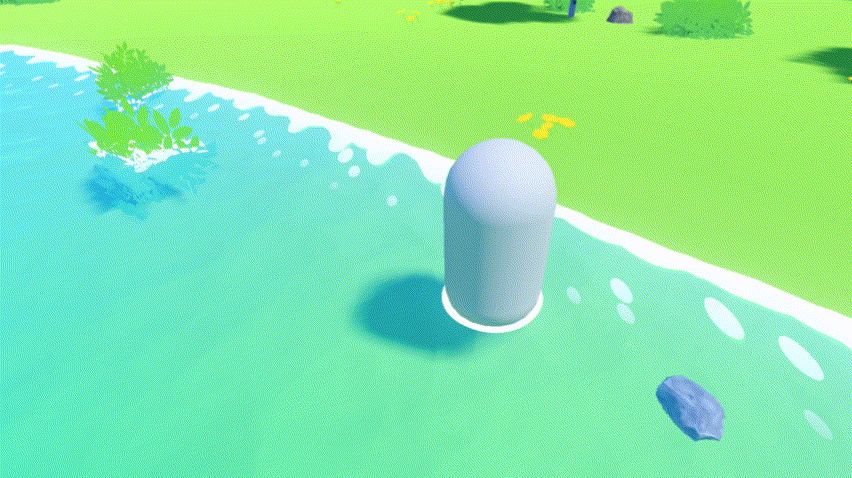


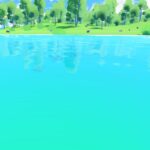
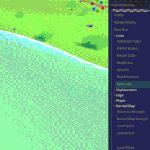
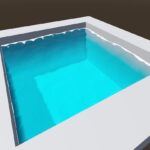

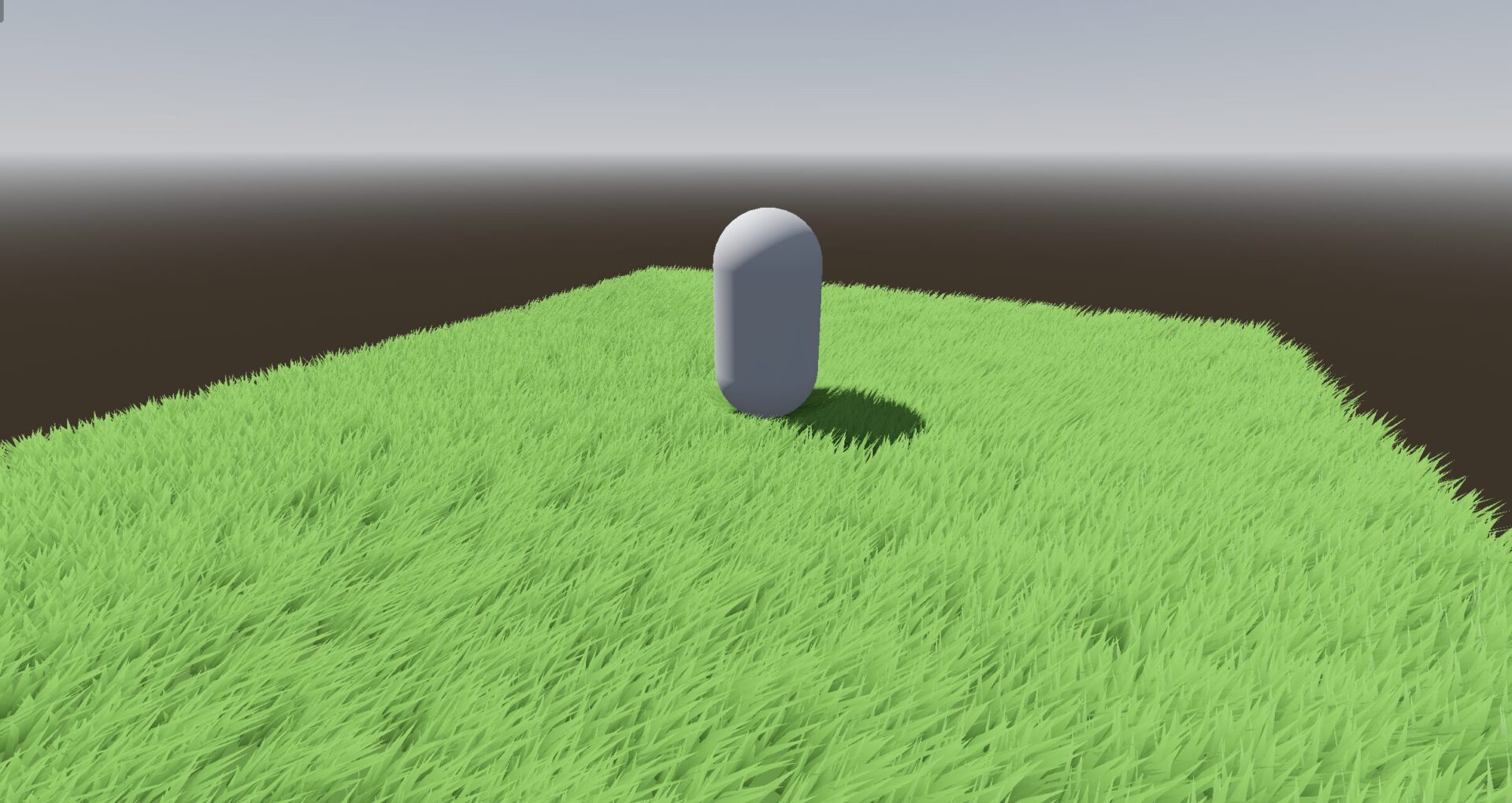

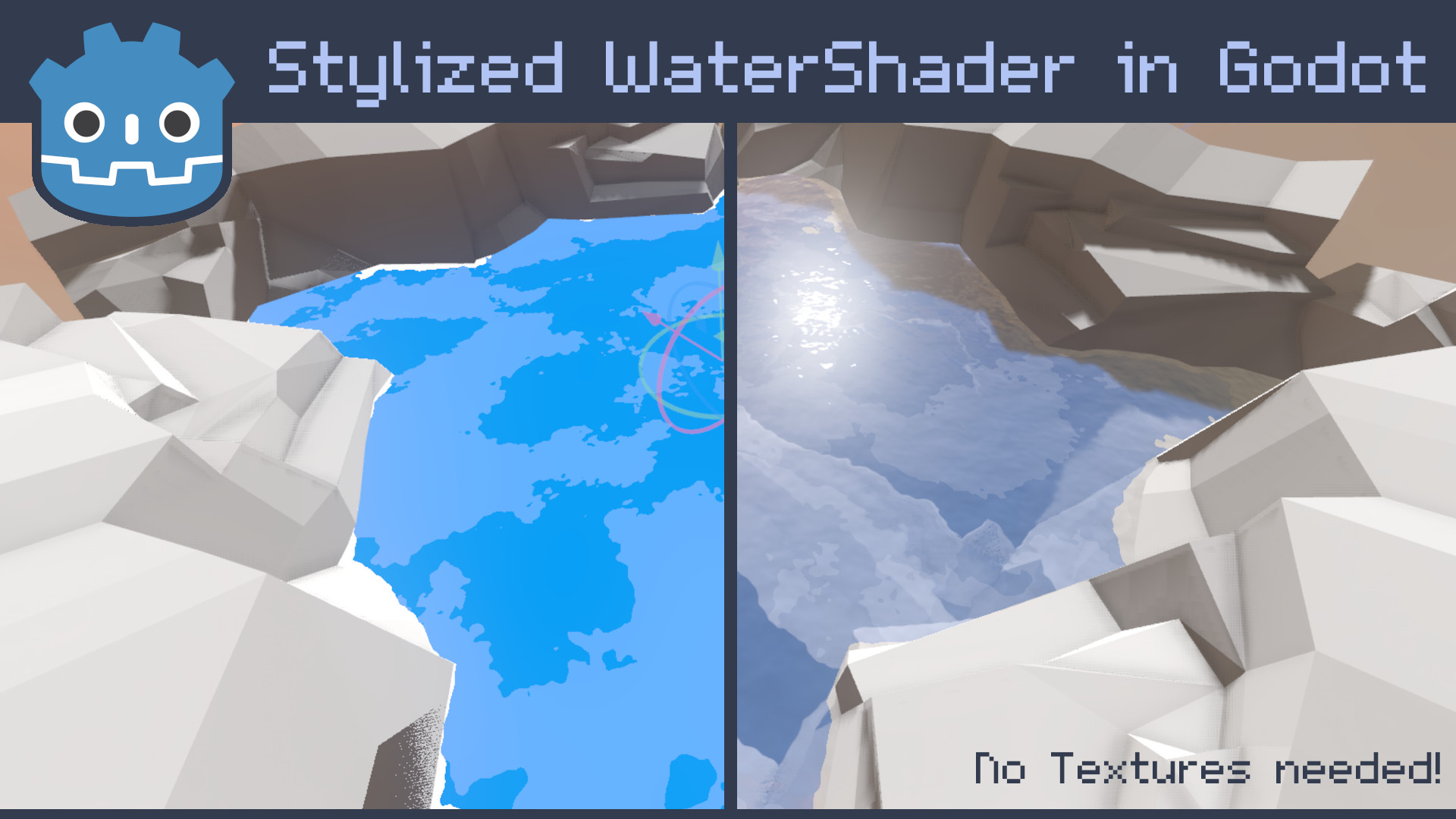
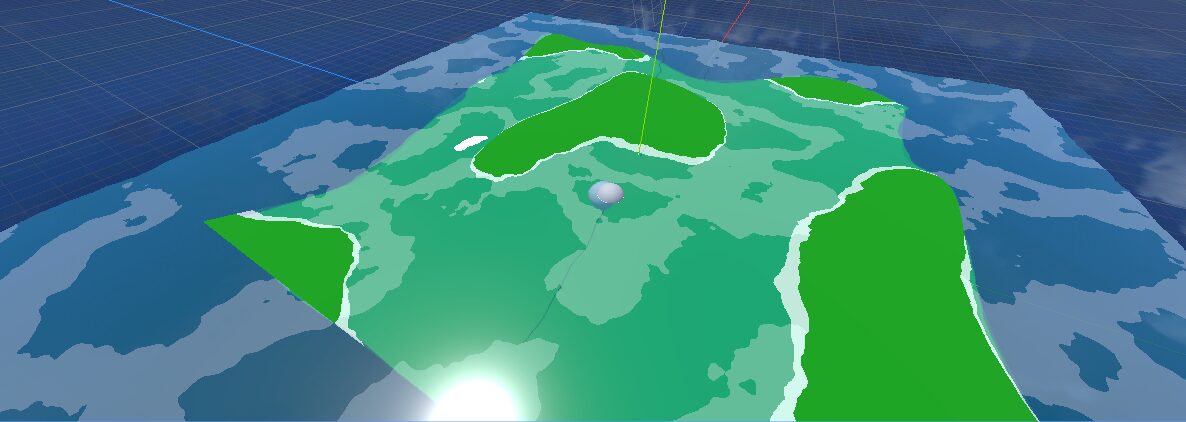
Amazing work! Thank you so much for sharing this! The best looking water shader for sure.
I’ve got problem getting player waves to work though. I’ve made shader global parameter of player_position and updating the position with my player’s position, and there do appear bubbles around the player in circular manner, but it doesn’t look as good as in your pic (it was like several bubbles only appearing very shortly, and doesn’t really look like waves).
Do you have any idea what might be causing that? Should I be offsetting the player_position’s height somehow? (I’m using tall humanoid model)
First off all, I appreciate that you like my Shader ^w^
You’re idea is going in the right direction. The area of these waves is influenced by the relative height from the fragment world height and the player_position so they don’t show up when your player is actually above the water.
You could offset the player_position uniform to the bottom of the characters collisions box like I did in my picture, or extend the height range at which the waves are shown by adding a number to player_relative.y in line 228:
By default, this Range is 2 Units high covering 1 Unit above and below. In this modified code this range is extended to 4 Units, but in this solution not the entire range is interpolated, but this could be perfect for tall characters.
This is incredible work and something I’ve been seeking for weeks! Big thanks for sharing this beautiful shader.
how do i make my godot not crash when i try to used this
Could you add more information such as error messages, your Godot version and the rendering method used (Compatibility Renderer is not supported due to the use of fma). I would appreciate if you open an issue on the GitHub page.
Hi first of all Ive to say this is a great shader!!! I love the colors and control so amazing work!!
I am just having a little issue that probably has to do with my lack of experience in Godot. The water looks very still in my scene specially the edges where it connects to other 3D objects. Is the speed of the waves or edges controlled somewhere outside the shader like the wind direction global setting?? I love how it looks on the preview you used and wondered how to get a similar effect. If you need screenshots or something from me please let me know and again thanks for sharing and offering support.
If you mean the vertex displaced waves, you probably need to subdivide the mesh you used with the water shader and adjust the displacement uniforms.
If you mean textures in general, you probably need to modify the global uniform wind_intensity and set it to 1.0. Normally it’s used to adjust the global wind speed at runtime.
Hi Malido! Your water shader is amazing! Even accounts for scaling with triplaning based on global position. Wonderful stuff 🙂 thank you for sharing, I’ll credit you in my project.
Also, I am making a HD2D game and noticed it doesn’t cull 3D sprites properly when putting them behind the water. Any workaround for this or ideas on what is causing it? I might just convert all my animated sprites to planes with a viewport so they are properly 3D.
Example: https://imgur.com/a/BNbn2XD
Thanks again!
The water will not cull anything by itself because it uses the screen texture and is therefore transparent. To fix transparency sorting issues you have to put the Sprite3D’s alpha_cut to Hash or discard so they are rendered before the water. If you want to hide your sprites completely when they are submerged, you can always use an occluder instance.
Hello, this is some great work but I am having trouble with some pixels bleeding possibly from depth texture when there is MSAA anti aliasing enabled. Also there’s some weird ghosting effect going around the edges or objects that are rendered in front of the water. Do you possibly know any fix for that? Please see attached gif.
https://imgur.com/a/6TZV5FH
The artifacts come from the non-aliased depth texture. I’d recommend using screen-space anti-aliasing instead.
I really enjoy this shader – it’s one of the best I’ve seen! I’ve made some slight modifications to better fit my project, and I’ve given you a mention in my last devlog: https://www.indiedb.com/games/theia/news/devlog-4-diving-into-water-effects-and-physics Thank you for your incredible work!
Amazing Stuff! I didn’t know my water could look that realistic.
I would really like to see how you implemented screen-space reflections. I’m currently using reflection probes, but to get good looking reflections you need quite a bit of VRAM.